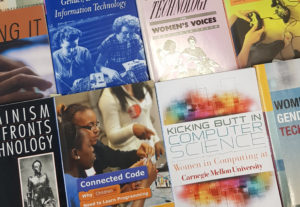 I had the great pleasure of talking for the regional conference “Næringsdagane” – the Business Days – 2018 for Sogn & Fjordane, at beautiful Kviknes hotel in Balestrand in beginning of May. One of the main topics of the conference was digitalisation across all sectors in society, and I was asked to talk about “women and technology” and to provide some answers to why there are so few women in IT education and occupations. The widespread digitalisation, after all, requires us to recruit from the entire population.
I had the great pleasure of talking for the regional conference “Næringsdagane” – the Business Days – 2018 for Sogn & Fjordane, at beautiful Kviknes hotel in Balestrand in beginning of May. One of the main topics of the conference was digitalisation across all sectors in society, and I was asked to talk about “women and technology” and to provide some answers to why there are so few women in IT education and occupations. The widespread digitalisation, after all, requires us to recruit from the entire population.
With my presentation titled “Programming and IT – who would have thought that would become a field for men?” I wanted to show that if we look back in time, there is an alternative story about women and technology, of “forgotten” female role models, including Ada Lovelace, Human Computers, the “ENIAC women”, and Grace Murray Hopper. Many women worked as programmers in the software business during the 1950s and 60s, and they did not think of programming as a field for men, as these quotes from Janet Abbate’s book Recoding Gender. Women’s Changing Participation in Computing from 2012 illustrate:
I was hired a programmer … It was something that women were believed to be good at
It really amazed me that these men were programmers, because I thought it was women’s work!
It never occurred to any of us that computer programming would eventually become something that was thought of as a men’s field
These images of women as suitable programmers, and programming as a suitable occupation for women, have since disappeared. The result is that we lack the vital images and good role models for girls and women to associate with in the field of IT.
In our work with Pillar 1 in NORDWIT we have interviewed women in technology related careers, and they illustrate how the lack of role models is still a challenge. When we asked about role models, one of the young women coming straight out of her master’s study said:
There were several IT companies visiting our class, but they were mostly men. It would have been more appealing and recognisable with a woman.
Another women told us:
I haven’t had any role models that… Because often there haven’t been anyone before us, in a way.
The low proportion of women is reflected in schools, with a low percentage of girls participating in the national pilot for programming in secondary school. “It’s hard to be what you cannot see”, Robin Hauser Reynolds has pointed out in an interview in USA Today. The campaign “#I-look-like-an-engineer” started after Isis Anchalee, featuring on an ad as an engineer, received a lot of attention in social media with comments doubting that she was a real engineer, suggesting she was rather a model hired to make the ad look good. History repeats itself, as the ENIAC women were also once interpreted that way – as “just refrigerator ladies posed in front of the machine to make it look good”.
How can we expect girls to choose programming at school facing a culture where even women who have chosen to work with IT can’t point at female role models, and where women who could have been role models are being distrusted as professionals?
Things obviously need to change!
It is possible to change this?
Yes!
Why?
Because history shows that today’s male dominance is not a given necessity, but a cultural construction.
How can we change it?
There is no quick fix, but still plenty of room for improvement:
- Don’t accept that “girls just aren’t interested”. Culture shapes interest!
- Be aware how you contribute to the image of IT. You are part of culture – make space for girls in IT.
- Be willing to change and always ask questions: What did we do to include girls? How can we change things to include more girls?
(This post was originally written for and posted to the Nordwit blog)
